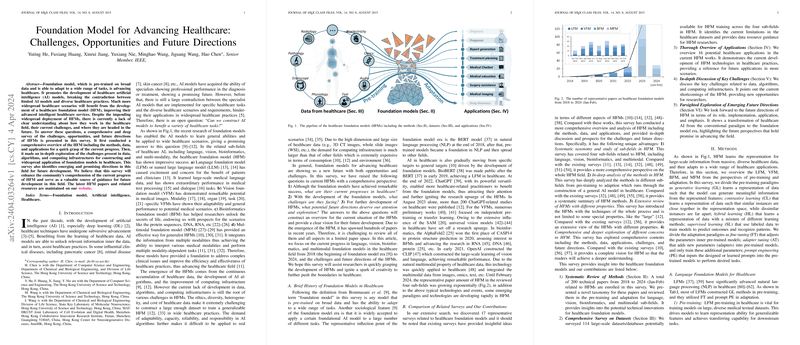Advancing Healthcare with Foundation Models: Opportunities and Challenges
Comprehensive Overview of Healthcare Foundation Models (HFMs)
Healthcare Foundation Models (HFMs) represent a transformative approach in applying AI to a wide spectrum of tasks in the healthcare domain. Leaning on the foundational model concept, HFMs are designed to harness broad data to learn general abilities that can be adapted to an expansive range of healthcare applications. This adaptation aims to mitigate the inherent contradiction between the specialized nature of existing AI models and the diverse requirements of healthcare practices. Recent research efforts underscore the notable progress of HFMs across various sub-fields of healthcare AI, such as language, vision, bioinformatics, and multimodality. This survey presents a systematic evaluation of the current status of HFMs, emphasizing their methodologies, underlying data, practical applications, and emerging challenges. It places a strong emphasis on language foundation models (LFMs), vision foundation models (VFMs), bioinformatics foundation models (BFMs), and multimodal foundation models (MFMs), assessing their contributions to improving intelligent healthcare services.
Methodological Insights Into HFMs
Language Foundation Models
LLMs in healthcare (LFMs) have demonstrated exceptional success, particularly in medical text processing and dialogue tasks. The pre-training of LFMs typically revolves around generative learning (GL) and contrastive learning (CL) paradigms, with fine-tuning (FT) and prompt engineering (PE) playing significant roles in adaptation. Models like GatorTronGPT and PMC-LLaMA exemplify this approach, showing the versatility of LFMs in handling various natural language processing tasks within the healthcare domain.
Vision Foundation Models
Vision foundation models (VFMs) have significantly advanced medical image analysis. They adopt supervised learning (SL), generative learning (GL), and contrastive learning (CL) for pre-training, with FT, AT, and PE extensively used for task adaptation. Models such as UNI and SAM-Med3D exemplify the potential of VFMs in medical image segmentation, showcasing their adaptability and superior performance in diverse medical scenarios.
Bioinformatics Foundation Models
Bioinformatics foundation models (BFMs) focus on leveraging large-scale biological data. They adopt a mix of generative learning (GL) and hybrid learning (HL) for pre-training, with fine-tuning (FT) being the predominant adaptation method. Models like RNA-FM and ESM-2 represent this approach, offering insights into the secrets of life and enhancing our understanding of protein sequences, DNA, and RNA.
Multimodal Foundation Models
The Multimodal Foundation Models (MFMs) integrate information from multiple modalities, achieving remarkable capability in interpreting medical data and performing cross-modality tasks. These models leverage a blend of generative, contrastive, and hybrid learning in pre-training, with fine-tuning (FT) and prompt engineering (PE) as essential for adaptation. The development of models such as BiomedGPT and RadFM highlights the significant advances in this field, demonstrating their effectiveness in multimodal healthcare settings.
Challenges and Future Directions
Despite the promising advancements in HFMs, several challenges persist, chiefly concerning data diversity, ethical considerations, algorithmic responsibility, and computational demands. Addressing these challenges requires concerted efforts in research, focusing on ethical data collection, enhancing algorithms' responsibility and reliability, and innovating for computational efficiency. Future developments in HFMs are likely to focus on fostering AI-human collaboration, enhancing models' dynamic capabilities, expanding applications to complex real-world scenarios, and emphasizing sustainability and trustworthiness.
In conclusion, HFMs hold immense promise in transforming healthcare through AI, offering sophisticated solutions that bridge the gap between specialized models and the broad spectrum of healthcare needs. Overcoming existing challenges and focusing on future directions will be crucial in unlocking the full potential of HFMs, paving the way for more advanced, reliable, and inclusive healthcare AI applications.
